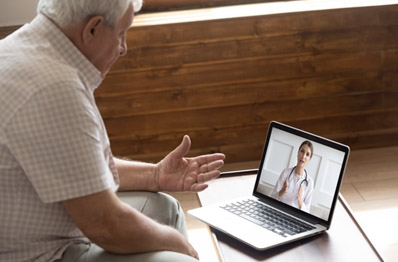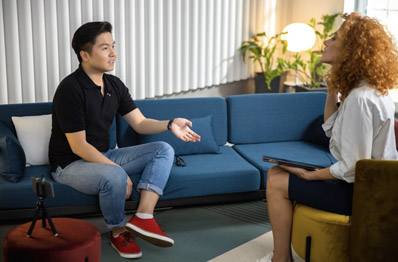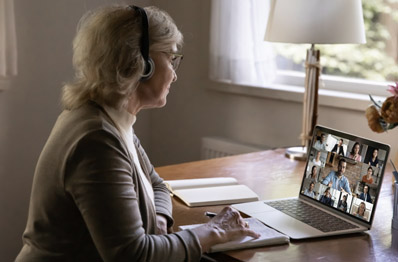GENERATION TO GENERATION
Preserving Our Past with Oral History
Introduction | Background Knowledge | Activities | Extensions | Standards

Introduction
History books and documentaries can tell facts. For example, they can tell when the wars started or when they ended. They can tell when things happened and where, but history books and documentaries often leave out the human aspect of history. Well before humans began to record history in writing, stories were passed from one generation to another. This practice has morphed into oral history. Oral history is a way to preserve the experiences of the people who lived through history that is preserved in books and documentaries.

Background Knowledge
According to the Oral History Association, "Oral history is a field of study and a method of gathering, preserving and interpreting the voices and memories of people, communities, and participants in past events. Oral history is both the oldest type of historical inquiry, predating the written word, and one of the most modern, initiated with tape recorders in the 1940s and now using 21st-century digital technologies." Oral history is a dialogue between the subject and the interviewer. When students are the interviewers, they learn history, but they are also learning to be historians.

ACTIVITIES
-
Choose the Topic and Choose the Subject
-
Examine your curriculum to see where you could enhance the content with oral history.
-
Younger Students:
- Then and Now
- Community Helpers
- Family
- Traditions and Customs
- Inventions
-
Older Students:
- State history
- Civil Rights
- Immigration
- Transportation
-
Younger Students:
- Identify the purpose of the interview. Brainstorm a list of interview questions. The Smithsonian Institute suggests a list of questions for oral histories.
- Brainstorm a list of people to interview. Contact all interviewees and schedule interviews.
- Identify and gather all equipment - computers, recording devices, cameras, etc. - to conduct the interview.
- Using a rubric like Quick Rubric (TeachersFisrt review), explain the final product expectations so students know what they will do with their information. Rubrics help ensure the students understand how they will be assessed.
-
Examine your curriculum to see where you could enhance the content with oral history.
-
Practice interview questions.
- Students can practice interview questions with a partner - this partner can be a trusted adult or another student.
-
Conduct the Interviews
- Invite a subject into the classroom and do a group interview, encouraging each student to ask a question.
- Create a class list of questions and have students complete individual interviews.
- Older students can transcribe the interview. Younger students can listen to or watch the recordings.
-
Complete the Final Product
-
Technology Approach
- Role-Playing - Make a video using Adobe Express Video Maker (TeachersFirst review). Students can record themselves as the person they interviewed to share with their classmates. If students are uncomfortable in front of the camera, try stop motion videos using Cloud Stop Motion (TeachersFirst review).
- Write a newspaper or magazine article. Use Flipsnack (TeachersFirst review) or Fodey (TeachersFirst review)
-
Non technology Approach
- Role-Playing - Students can present to their classmates as the person they interviewed.
- Write a newspaper or magazine article.
-
Technology Approach

EXTENSIONS
-
Compare the Oral History to Other Sources
- Oral history can fill in the blanks that other sources leave behind. Challenge students to identify what is missing from a history unit. For example, in this article about the 1918 Spanish Flu Pandemic from the CDC, the text tells that children aged 6-19 had a lower mortality rate than other age groups. However, this oral history tells a different story from the perspective of a school-aged child. Both accounts are correct - the CDC gives facts and numbers, but the oral history brings in the human aspect of being a student during the pandemic.
-
Compare Oral History to Storytelling
- There are many similarities between sharing oral history and storytelling. However, storytelling will often incorporate legend and folklore and students must be cautioned to think critically while being respectful. Visit the International Storytelling Center (TeachersFirst review) for ideas and background information.
-
Connect to Literature
-
The easiest place to start working with oral history is through families. Even primary-aged students can interview family members to learn about the past. Begin with picture books; use them to engage in conversation about what is important about the story. This discussion can help younger students brainstorm interview questions. Reading Rockets suggests the following books as preparation for interviewing grandparents for oral history:
- Song and Dance Man by Karen Ackerman (ISBN 9780679819950)
- Nana Upstairs and Nana Downstairs by Tomie dePaola (ISBN 9780698118362)
- My Grandmother's Cookie Jar by Montzalee Miller (ISBN 9780843115871)
- Grandfather's Journey by Allen Say (ISBN 9780544050501)
-
The easiest place to start working with oral history is through families. Even primary-aged students can interview family members to learn about the past. Begin with picture books; use them to engage in conversation about what is important about the story. This discussion can help younger students brainstorm interview questions. Reading Rockets suggests the following books as preparation for interviewing grandparents for oral history:

CORRELATION TO STANDARDS
-
AASL National School Library Standards
- Inquire Shared Foundation, Think Domain - Learners display curiosity and initiative by: 1. Formulating questions about a personal interest or a curricular topic. 2. Recalling prior and background knowledge as context for new meaning
- Inquire Shared Foundation, Grow Domain - Learners participate in an ongoing inquiry-based process by: 1. Continually seeking knowledge
- Include Shared Foundation, Create Domain - Learners adjust their awareness of the global learning community by:. 2. Evaluating a variety of perspectives during learning activities
- Include Shared Foundation, Grow Domain - Learners demonstrate empathy and equity in knowledge building within the global learning community by: 2. Demonstrating interest in other perspectives during learning activities
- Curate Shared Foundation, Create Domain - Learners gather information appropriate to the task by: 2. Collecting information representing diverse perspectives
- Explore Shared Foundation, Share Domain - Learners engage with the learning community by: 1. Expressing curiosity about a topic of personal interest or curricular relevance
-
ISTE Standards for Students
- Empowered Learner - 1a. Students articulate and set personal learning goals, develop strategies leveraging technology to achieve them and reflect on the learning process itself to improve learning outcomes.
- Knowledge Constructor - 3a. Students plan and employ effective research strategies to locate information and other resources for their intellectual or creative pursuits.
- Knowledge Constructor - 3d. Students build knowledge by actively exploring real-world issues and problems, developing ideas and theories and pursuing answers and solutions.
- Innovative Designer - 4d. Students exhibit a tolerance for ambiguity, perseverance and the capacity to work with open-ended problems.
- Creative Communicator - 6a. Students chose the appropriate platforms and tools for meeting the desired objectives of their creation or communication.
- Creative Communicator - 6d. Students publish or present content that customizes the message and medium for their intended audiences.
- Global Collaborator - 7b. Students use collaborative technologies to work with others, including peers, experts or community members, to examine issues and problems from multiple viewpoints.
